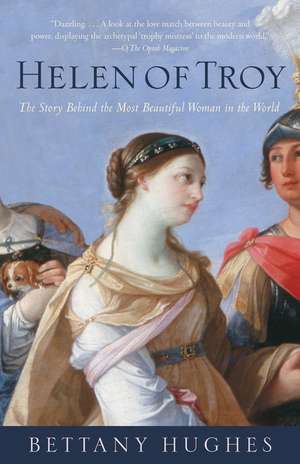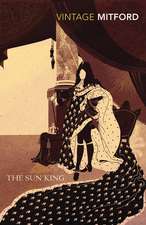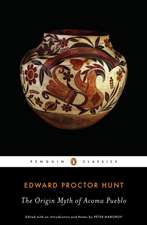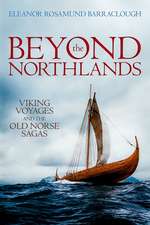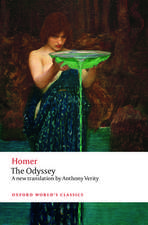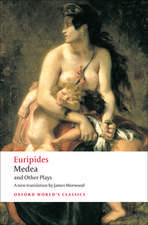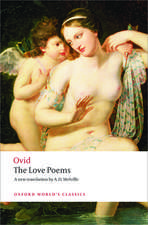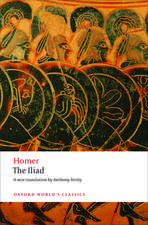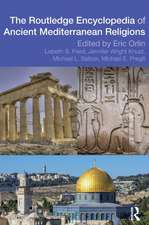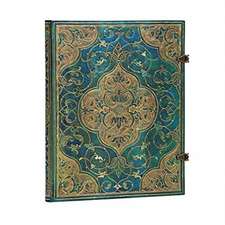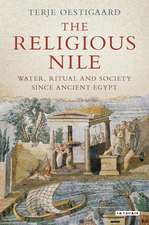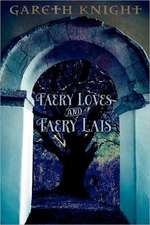Helen of Troy: The Story Behind the Most Beautiful Woman in the World
Autor Bettany Hughesen Limba Engleză Paperback – 31 oct 2006
| Toate formatele și edițiile | Preț | Express |
|---|---|---|
| Paperback (2) | 136.56 lei 24-35 zile | +66.31 lei 4-10 zile |
| Vintage Publishing – 7 noi 2013 | 136.56 lei 24-35 zile | +66.31 lei 4-10 zile |
| Vintage Books USA – 31 oct 2006 | 143.48 lei 6-8 săpt. |
Preț: 143.48 lei
Nou
Puncte Express: 215
Preț estimativ în valută:
27.46€ • 28.56$ • 22.67£
27.46€ • 28.56$ • 22.67£
Carte tipărită la comandă
Livrare economică 15-29 aprilie
Preluare comenzi: 021 569.72.76
Specificații
ISBN-13: 9781400076000
ISBN-10: 1400076005
Pagini: 458
Ilustrații: 16 PP COLOR; 16 PP B&W; 6 MAPS
Dimensiuni: 134 x 202 x 26 mm
Greutate: 0.49 kg
Editura: Vintage Books USA
ISBN-10: 1400076005
Pagini: 458
Ilustrații: 16 PP COLOR; 16 PP B&W; 6 MAPS
Dimensiuni: 134 x 202 x 26 mm
Greutate: 0.49 kg
Editura: Vintage Books USA
Notă biografică
Bettany Hughes is a cultural and social historian, writer, and television presenter. She received degrees in ancient and medieval history at Oxford University and has carried out research in the Balkans, Greece, and Asia Minor. She has presented numerous documentaries and historical series for the BBC, PBS, and the Discovery Channel, and also writes pieces on popular history for several newspapers and magazines.
Extras
Chapter 1
A DANGEROUS LANDSCAPE
Suddenly down from the mountain’s rocky crags Poseidon stormed with giant, lightning strides and the looming peaks and tall timber quaked beneath his immortal feet as the sea lord surged on. —Homer, Iliad
To understand the disquiet landscape that nurtured Helen, we must begin our story 175 miles south-east from Sparta, Helen’s traditional birthplace, across the Aegean Sea on the Cycladic island of Thera. Here, over three and a half thousand years ago, a single, cataclysmic event directed the course of western civilisation.
Between 1859 and 1869, labour-gangs were employed on the island of Thera to quarry raw materials for cement. Huge amounts were needed: this was preparatory work for the construction of the new canal at Suez. The workers were after pozzolan, a powdered pumice-stone which, combined with lime, produces a cement so fine that it is like plaster; they were digging in the right place. Here were layers of pumice a full 10 m thick: the tell-tale sign of massive geo-physical activity. The volcanic island of Thera had erupted a number of times, and as the navvies dug deeper and deeper it became clear that the most spectacular explosion pre-dated the Romans, the classical Greeks and Homer himself. When the pick-axes finally hit the bedrock, the workers had made their way through extruded volcanic material 3,500 years old to the archaeological level of the Aegean Bronze Age. What was being quarried was the fall-out of a gargantuan natural disaster.
The landscape of present-day Thera still signals the force of an earth that is uneasy. Take a little boat out to the collapsed centre of the volcano and you crunch your way through its hills and hummocks built up of dusty, aerated lava. Pumice stones skitter and slide underfoot at the approach to the volcano’s centre. The ground still breathes out attenuated plumes and wisps of smoke. Footpaths wind past giant rocky outcrops: once molten ooze, these subterranean minerals have now hardened into titanic chunks of shiny, black, broken treacle. For centuries, the Theran landscape would have been a stark aide-memoire, telling the ancients that men were mere matchwood when it came to the anger of the earth, the sea and the sky.
Thera is a shocking and savage enough place today – just imagine it as the volcano erupted around 1550 bc. Earthquakes a month or so before would have been the first signal that the gods were uneasy. Then the massive mountain in the sea would have started to exhale clouds of ash, a dark stain in the sky, an ugly blur visible for a hundred miles. With a scream of released pressure, steam would have escaped in voluminous billows and tight jet-blasts. And then the coup de théâtre: between 30 and 40 km of pumice, rock-shards and ash hurtling into the atmosphere in the giant eruption column. Magma spewing up from the volcano’s mouth; pyroclastic flows leaving deposits 20 to 50 m thick in some places; electrical storms ripping open the sky.
Although it may have taken only three or four days for the volcano to erupt, the effects were far-reaching. The global temperature would have gone down as volcanic aerosols were released, blocking solar radiation to the earth’s surface. As far away as Lake Golcuk in the Bozdag mountain range in Turkey, 320 miles north-east of Thera, a 12 cm-thick layer of Theran tephra has been found. Sediment cores from the Black Sea also contain Theran material. Ash would have drifted over an area of 500,000 square km, smothering crops, stifling livestock.
Following the volcanic eruption there were other horrors to come. As sea water was displaced by the shift of the earth and rushed into the collapsed magma chamber – the newly gaping Theran caldera sinking over 480 m below sea level – a giant wave, a tsunami, began to gather and hurtle towards shores in the region. It is estimated that the largest tsunami created by the eruption of Thera – just one in a train of waves – would have been up to 12 m high, travelling at well over 160 km per hour.6 Just 111 km away, the north coast of Crete was particularly badly hit. Near the Bronze Age palace of Malia on the island, tiny fossilised sea-shells have been found in mud deposits, shells that under normal conditions exist only in deep ocean. Small boats would have been plucked from the shallows and hurled onto the hills. And as the decomposing bodies of the volcano’s victims were washed back ashore, diarrhoeal diseases – cholera and typhoid – would have spread. The destruction and death toll would have been immense. The Bronze Age world was brutalised.
But for one group of people who lived in scattered settlements on the Greek mainland, the explosion of Thera offered an unexpected opportunity.
From the 19th to the 15th centuries bc, the islanders of Crete – the Minoans (thus named in 1895 by the archaeologist Arthur Evans after the legendary ruler of Crete, King Minos) – had dominated the sea-ways of the Aegean. Floating between Europe, the Middle East and Africa, the Minoans successfully exploited their pole position. For five hundred years communities around the Eastern Mediterranean not only traded with ‘the people of Keftiu’, as the Minoans were probably known in the Bronze Age, but also followed their political and religious lead. Secure on their island home, the Minoans were wealthy, vigorous and influential. They have been described as a ‘thalassocracy’ – a sea-power, rulers of the waves.
The eruption of Thera changed Minoan fortunes. This was a sophisticated culture, a culture that relied on contacts with the outside world to keep its workshops fed with tin and copper, with semi-precious stones and with oils and unguents. But all boats moored along the busy north and east coasts of the island – a fleet essential for Minoan well-being – would have been destroyed by the tsunami that followed the Thera eruption. Patterns of trade and communication across the Aegean were disrupted. Vital farmland was flooded. As refugees fled Thera itself they could have brought with them unfamiliar pathogens which would have radiated quickly from the crowded shanty towns that mushroomed on Cretan coastlines.
The psychological impact of the disaster must have been far-reaching. For a fundamentally superstitious pre-historic culture like the Minoans, a perversion of nature such as this could be explained only in spiritual terms. The column of water which appeared from nowhere and hit the island at a horrifying, incomprehensible speed, the eerie afterglow of the volcanic explosion hanging on the horizon, must have been interpreted as momentous signs from enraged gods. The confidence of the Minoans – who had, for centuries, seemed blessed – would have been shaken to its core.
Helen’s Mycenaean ancestors were equipped to step into the breach.
The Mycenaean civilisation first comes into focus around 1700 bc. Centred on mainland Greece – particularly its southern landmass, the Peloponnese – the Mycenaeans founded citadels, carved up agricultural districts and established a network of roads and trade-routes. This was a well-organised, ambitious and materialistic culture; each generation of the warrior-elite expanded Mycenaean territories and the treasure stores of Mycenaean palaces. As the Mycenaeans looked to the south, Minoan palaces and ports must have tempted them – control of Cretan territories would have offered a clear trade-route through to Egypt and across to Asia Minor. It is little surprise that after years as a fledgling culture, when the Mycenaeans decided to spread their wings, they had Crete in their sights. Thera’s explosion triggered a political as well as a geological shift in power.
Throughout the 16th century bc the Minoans appear slowly to lose their grip on the Aegean; then, around 1450 bc we find Mycenaean pottery simply replacing Minoan artefacts. At the great palace complex of Knossos in the north of the island, a Mycenaean administration takes the reins. Across the island, fires destroy all other palatial centres. All Minoan administrative records come to be written in the Greek language. Independent Minoan culture is eclipsed. For the next three hundred years it would be the Mycenaean Greeks, not the Minoans, who dominated the region. Following the eruption of Thera, the leaders of the mainland Greeks slowly join the ranks of the most powerful men on earth – by the 13th century bc Helen’s ancestors are, like the rulers of Egypt, Babylonia, Assyria and Anatolia, described as ‘Great Kings’.
And so, although many artists have imagined Helen and her peers as soft, sun-kissed creatures, wafting indolently in front of classically fluted columns in diaphanous chitons, if we are to hold in our mind a picture of the real women of the Late Bronze Age and the environment they inhabited, we must add harsher colours to the palette.
The eruption of Thera was the most showy disaster in the Late Bronze Age, but there were others. This was a fragile, edgy epoch in which communities were frequently destabilised by both political and environmental forces. The Eastern Mediterranean stretches over a tectonic-plate boundary – a zone where two plates in the earth’s crust push and pull like testy lovers; Helen’s story is set in one of the most seismic – as well as one of the most volcanic – regions of the world. In addition to the extreme eruption of Thera, for the Late Bronze Age populations of the Aegean natural disasters were regular and unwelcome visitors. There were ‘storms’ of earthquakes, as well as unusually frequent cosmic activity. From the 14th to the 12th centuries, on average, the Peloponnese would have suffered an earth tremor, an earthquake, or a cosmic strike every decade.
Across the Bronze Age Aegean there is evidence of these disasters in the form of ‘destruction layers’ – jumbled masses of disjointed architecture, artefacts, plant and animal remains. Everyday objects in the archaeological strata are in unlikely places or positions. In the most extreme examples, debris has been pulverised or burnt, human bones are crushed in rubble; the disorder bears witness to moments of great crisis. At Thebes – the main Mycenaean settlement in Boiotia, central Greece, which Homer tells us contributed fifty ships to the Trojan War effort – a destruction layer from a Mycenaean building on the hill of Kadmeia is a full metre thick. Trapped in one horribly compressed upper room is a skeleton, probably that of a woman aged between twenty and twenty-five, who seems to have been killed by a violent blow to the head as the building was ripped apart.
Destruction layers witness trauma. They are public signifiers of private tragedies – but there were also devastating events that leave little archaeological trace. Landslides and dust-clouds, water springs blocked at the source, flash floods, rivers diverted: life abrupted.15 From 1800 to 1100 bc many of the settlements in the Eastern Mediterranean appear to have been hit not once, but repeatedly.16 Helen’s inheritance was vexed. She was born as a woman or as an idea when heaven and earth were in pugnacious mood. The mortar binding the foundation myths in a court such as hers would have been streaked with blood. The Mycenaeans clawed their way to prominence in the Eastern Mediterranean over rubble and detritus and broken lives; theirs was an ascent back-lit by flames. As they reach supremacy in the 13th century bc, the smell of death – whether brought by man or by nature – still hangs in the air.
Little surprise that Helen’s story is brooding and uncomfortable.
Chapter 2
A RAPE, A BIRTH
A shudder in the loins engenders there
The broken wall, the burning roof and tower
And Agamemnon dead.
—W.B. Yeats, ‘Leda and the Swan’ (1928)
Helen’s traditional breeding-place, the Peloponnese in the southern Greek mainland, is, even when not rocked by natural disasters, a place of extremes. In her home town, Sparta, summer temperatures can reach up to 104 degrees Fahrenheit (40 degrees Celsius), while in the winter choking mists clog up the valleys and the almond trees are laced with hoar-frost. High in the mountains that ring the town, there are icicles the size of a grown man. Widows at the roadside will tell how the weak and very poor still die from the cold. This can be a savage land and it has given birth to correspondingly savage stories.
Helen’s conception is a prime example. According to Greek myths, Helen came from good stock, but her genesis was violent. Her father, Zeus, was chief among the pantheon on Mount Olympus. Helen was Zeus’ cherished and only mortal daughter. Her mother, Leda,1 the wife of Tyndareus, King of Sparta, was famed for her beauty. One day, as Leda bathed on the banks of the Eurotas, the lush river that irrigates the Spartan plain, Zeus saw the young queen and was enraptured. Determined to have Leda, he turned himself into a giant swan and raped her.
In classical Athens, remembering these distant stories, the chorus in Euripides’ play Helen bemoans the moment: ‘so sorrowful was that destiny, lady mine, that befell you, a life better unlived given to you, yes given, when Zeus blazed in the bright air, in the snowflash of the swan’s wing to beget you upon your mother. What grief is there you have not known? What in life have you not lived through?
It was a beginning recalled as being at once brutal and erotic. In a mosaic from a sanctuary of Aphrodite at Paphos on Cyprus a gloriously plump-bottomed Leda, with her back to us, runs the edge of her gossamer shawl over the swan’s beak. Early Greek representations of the story are relatively tame, the bird small, with Leda simply petting him. But as time goes on, the bird grows bigger, the atmosphere more violent. In Argos, a tombstone commissioned by a rich Greek merchant immortalises in marble the moment when the swan enters the young woman. The sculpture stands at the entrance of the small Argos Museum. Leda is doubled over – in pain or in ecstasy – her hand making its way towards her vulva. It is impossible to tell whether she is trying to drag Zeus out or help him in. In a wall-painting from Herculaneum, the town buried along with Pompeii by the eruption of Vesuvius in ad 79, the fowl-god bites Leda’s neck. Michelangelo’s 16th-century Leda seems to be abandoned to sensual pleasure; after its donation in 1838, a copy of the painting was hung in the office of the director of London’s National Gallery rather than put on display as it was considered inappropriate for the public gaze.
A DANGEROUS LANDSCAPE
Suddenly down from the mountain’s rocky crags Poseidon stormed with giant, lightning strides and the looming peaks and tall timber quaked beneath his immortal feet as the sea lord surged on. —Homer, Iliad
To understand the disquiet landscape that nurtured Helen, we must begin our story 175 miles south-east from Sparta, Helen’s traditional birthplace, across the Aegean Sea on the Cycladic island of Thera. Here, over three and a half thousand years ago, a single, cataclysmic event directed the course of western civilisation.
Between 1859 and 1869, labour-gangs were employed on the island of Thera to quarry raw materials for cement. Huge amounts were needed: this was preparatory work for the construction of the new canal at Suez. The workers were after pozzolan, a powdered pumice-stone which, combined with lime, produces a cement so fine that it is like plaster; they were digging in the right place. Here were layers of pumice a full 10 m thick: the tell-tale sign of massive geo-physical activity. The volcanic island of Thera had erupted a number of times, and as the navvies dug deeper and deeper it became clear that the most spectacular explosion pre-dated the Romans, the classical Greeks and Homer himself. When the pick-axes finally hit the bedrock, the workers had made their way through extruded volcanic material 3,500 years old to the archaeological level of the Aegean Bronze Age. What was being quarried was the fall-out of a gargantuan natural disaster.
The landscape of present-day Thera still signals the force of an earth that is uneasy. Take a little boat out to the collapsed centre of the volcano and you crunch your way through its hills and hummocks built up of dusty, aerated lava. Pumice stones skitter and slide underfoot at the approach to the volcano’s centre. The ground still breathes out attenuated plumes and wisps of smoke. Footpaths wind past giant rocky outcrops: once molten ooze, these subterranean minerals have now hardened into titanic chunks of shiny, black, broken treacle. For centuries, the Theran landscape would have been a stark aide-memoire, telling the ancients that men were mere matchwood when it came to the anger of the earth, the sea and the sky.
Thera is a shocking and savage enough place today – just imagine it as the volcano erupted around 1550 bc. Earthquakes a month or so before would have been the first signal that the gods were uneasy. Then the massive mountain in the sea would have started to exhale clouds of ash, a dark stain in the sky, an ugly blur visible for a hundred miles. With a scream of released pressure, steam would have escaped in voluminous billows and tight jet-blasts. And then the coup de théâtre: between 30 and 40 km of pumice, rock-shards and ash hurtling into the atmosphere in the giant eruption column. Magma spewing up from the volcano’s mouth; pyroclastic flows leaving deposits 20 to 50 m thick in some places; electrical storms ripping open the sky.
Although it may have taken only three or four days for the volcano to erupt, the effects were far-reaching. The global temperature would have gone down as volcanic aerosols were released, blocking solar radiation to the earth’s surface. As far away as Lake Golcuk in the Bozdag mountain range in Turkey, 320 miles north-east of Thera, a 12 cm-thick layer of Theran tephra has been found. Sediment cores from the Black Sea also contain Theran material. Ash would have drifted over an area of 500,000 square km, smothering crops, stifling livestock.
Following the volcanic eruption there were other horrors to come. As sea water was displaced by the shift of the earth and rushed into the collapsed magma chamber – the newly gaping Theran caldera sinking over 480 m below sea level – a giant wave, a tsunami, began to gather and hurtle towards shores in the region. It is estimated that the largest tsunami created by the eruption of Thera – just one in a train of waves – would have been up to 12 m high, travelling at well over 160 km per hour.6 Just 111 km away, the north coast of Crete was particularly badly hit. Near the Bronze Age palace of Malia on the island, tiny fossilised sea-shells have been found in mud deposits, shells that under normal conditions exist only in deep ocean. Small boats would have been plucked from the shallows and hurled onto the hills. And as the decomposing bodies of the volcano’s victims were washed back ashore, diarrhoeal diseases – cholera and typhoid – would have spread. The destruction and death toll would have been immense. The Bronze Age world was brutalised.
But for one group of people who lived in scattered settlements on the Greek mainland, the explosion of Thera offered an unexpected opportunity.
From the 19th to the 15th centuries bc, the islanders of Crete – the Minoans (thus named in 1895 by the archaeologist Arthur Evans after the legendary ruler of Crete, King Minos) – had dominated the sea-ways of the Aegean. Floating between Europe, the Middle East and Africa, the Minoans successfully exploited their pole position. For five hundred years communities around the Eastern Mediterranean not only traded with ‘the people of Keftiu’, as the Minoans were probably known in the Bronze Age, but also followed their political and religious lead. Secure on their island home, the Minoans were wealthy, vigorous and influential. They have been described as a ‘thalassocracy’ – a sea-power, rulers of the waves.
The eruption of Thera changed Minoan fortunes. This was a sophisticated culture, a culture that relied on contacts with the outside world to keep its workshops fed with tin and copper, with semi-precious stones and with oils and unguents. But all boats moored along the busy north and east coasts of the island – a fleet essential for Minoan well-being – would have been destroyed by the tsunami that followed the Thera eruption. Patterns of trade and communication across the Aegean were disrupted. Vital farmland was flooded. As refugees fled Thera itself they could have brought with them unfamiliar pathogens which would have radiated quickly from the crowded shanty towns that mushroomed on Cretan coastlines.
The psychological impact of the disaster must have been far-reaching. For a fundamentally superstitious pre-historic culture like the Minoans, a perversion of nature such as this could be explained only in spiritual terms. The column of water which appeared from nowhere and hit the island at a horrifying, incomprehensible speed, the eerie afterglow of the volcanic explosion hanging on the horizon, must have been interpreted as momentous signs from enraged gods. The confidence of the Minoans – who had, for centuries, seemed blessed – would have been shaken to its core.
Helen’s Mycenaean ancestors were equipped to step into the breach.
The Mycenaean civilisation first comes into focus around 1700 bc. Centred on mainland Greece – particularly its southern landmass, the Peloponnese – the Mycenaeans founded citadels, carved up agricultural districts and established a network of roads and trade-routes. This was a well-organised, ambitious and materialistic culture; each generation of the warrior-elite expanded Mycenaean territories and the treasure stores of Mycenaean palaces. As the Mycenaeans looked to the south, Minoan palaces and ports must have tempted them – control of Cretan territories would have offered a clear trade-route through to Egypt and across to Asia Minor. It is little surprise that after years as a fledgling culture, when the Mycenaeans decided to spread their wings, they had Crete in their sights. Thera’s explosion triggered a political as well as a geological shift in power.
Throughout the 16th century bc the Minoans appear slowly to lose their grip on the Aegean; then, around 1450 bc we find Mycenaean pottery simply replacing Minoan artefacts. At the great palace complex of Knossos in the north of the island, a Mycenaean administration takes the reins. Across the island, fires destroy all other palatial centres. All Minoan administrative records come to be written in the Greek language. Independent Minoan culture is eclipsed. For the next three hundred years it would be the Mycenaean Greeks, not the Minoans, who dominated the region. Following the eruption of Thera, the leaders of the mainland Greeks slowly join the ranks of the most powerful men on earth – by the 13th century bc Helen’s ancestors are, like the rulers of Egypt, Babylonia, Assyria and Anatolia, described as ‘Great Kings’.
And so, although many artists have imagined Helen and her peers as soft, sun-kissed creatures, wafting indolently in front of classically fluted columns in diaphanous chitons, if we are to hold in our mind a picture of the real women of the Late Bronze Age and the environment they inhabited, we must add harsher colours to the palette.
The eruption of Thera was the most showy disaster in the Late Bronze Age, but there were others. This was a fragile, edgy epoch in which communities were frequently destabilised by both political and environmental forces. The Eastern Mediterranean stretches over a tectonic-plate boundary – a zone where two plates in the earth’s crust push and pull like testy lovers; Helen’s story is set in one of the most seismic – as well as one of the most volcanic – regions of the world. In addition to the extreme eruption of Thera, for the Late Bronze Age populations of the Aegean natural disasters were regular and unwelcome visitors. There were ‘storms’ of earthquakes, as well as unusually frequent cosmic activity. From the 14th to the 12th centuries, on average, the Peloponnese would have suffered an earth tremor, an earthquake, or a cosmic strike every decade.
Across the Bronze Age Aegean there is evidence of these disasters in the form of ‘destruction layers’ – jumbled masses of disjointed architecture, artefacts, plant and animal remains. Everyday objects in the archaeological strata are in unlikely places or positions. In the most extreme examples, debris has been pulverised or burnt, human bones are crushed in rubble; the disorder bears witness to moments of great crisis. At Thebes – the main Mycenaean settlement in Boiotia, central Greece, which Homer tells us contributed fifty ships to the Trojan War effort – a destruction layer from a Mycenaean building on the hill of Kadmeia is a full metre thick. Trapped in one horribly compressed upper room is a skeleton, probably that of a woman aged between twenty and twenty-five, who seems to have been killed by a violent blow to the head as the building was ripped apart.
Destruction layers witness trauma. They are public signifiers of private tragedies – but there were also devastating events that leave little archaeological trace. Landslides and dust-clouds, water springs blocked at the source, flash floods, rivers diverted: life abrupted.15 From 1800 to 1100 bc many of the settlements in the Eastern Mediterranean appear to have been hit not once, but repeatedly.16 Helen’s inheritance was vexed. She was born as a woman or as an idea when heaven and earth were in pugnacious mood. The mortar binding the foundation myths in a court such as hers would have been streaked with blood. The Mycenaeans clawed their way to prominence in the Eastern Mediterranean over rubble and detritus and broken lives; theirs was an ascent back-lit by flames. As they reach supremacy in the 13th century bc, the smell of death – whether brought by man or by nature – still hangs in the air.
Little surprise that Helen’s story is brooding and uncomfortable.
Chapter 2
A RAPE, A BIRTH
A shudder in the loins engenders there
The broken wall, the burning roof and tower
And Agamemnon dead.
—W.B. Yeats, ‘Leda and the Swan’ (1928)
Helen’s traditional breeding-place, the Peloponnese in the southern Greek mainland, is, even when not rocked by natural disasters, a place of extremes. In her home town, Sparta, summer temperatures can reach up to 104 degrees Fahrenheit (40 degrees Celsius), while in the winter choking mists clog up the valleys and the almond trees are laced with hoar-frost. High in the mountains that ring the town, there are icicles the size of a grown man. Widows at the roadside will tell how the weak and very poor still die from the cold. This can be a savage land and it has given birth to correspondingly savage stories.
Helen’s conception is a prime example. According to Greek myths, Helen came from good stock, but her genesis was violent. Her father, Zeus, was chief among the pantheon on Mount Olympus. Helen was Zeus’ cherished and only mortal daughter. Her mother, Leda,1 the wife of Tyndareus, King of Sparta, was famed for her beauty. One day, as Leda bathed on the banks of the Eurotas, the lush river that irrigates the Spartan plain, Zeus saw the young queen and was enraptured. Determined to have Leda, he turned himself into a giant swan and raped her.
In classical Athens, remembering these distant stories, the chorus in Euripides’ play Helen bemoans the moment: ‘so sorrowful was that destiny, lady mine, that befell you, a life better unlived given to you, yes given, when Zeus blazed in the bright air, in the snowflash of the swan’s wing to beget you upon your mother. What grief is there you have not known? What in life have you not lived through?
It was a beginning recalled as being at once brutal and erotic. In a mosaic from a sanctuary of Aphrodite at Paphos on Cyprus a gloriously plump-bottomed Leda, with her back to us, runs the edge of her gossamer shawl over the swan’s beak. Early Greek representations of the story are relatively tame, the bird small, with Leda simply petting him. But as time goes on, the bird grows bigger, the atmosphere more violent. In Argos, a tombstone commissioned by a rich Greek merchant immortalises in marble the moment when the swan enters the young woman. The sculpture stands at the entrance of the small Argos Museum. Leda is doubled over – in pain or in ecstasy – her hand making its way towards her vulva. It is impossible to tell whether she is trying to drag Zeus out or help him in. In a wall-painting from Herculaneum, the town buried along with Pompeii by the eruption of Vesuvius in ad 79, the fowl-god bites Leda’s neck. Michelangelo’s 16th-century Leda seems to be abandoned to sensual pleasure; after its donation in 1838, a copy of the painting was hung in the office of the director of London’s National Gallery rather than put on display as it was considered inappropriate for the public gaze.
Recenzii
“Dazzling. . . A look at the love match between beauty and power, displaying the archetypal ‘trophy mistress” to the modern world.” –O, The Oprah Magazine
“A divine biography. . . . Sizzling. . . . [Hughes] , a young British historian, explores not only the Bronze Age babe but also what she has meant throughout history and the cultural significance of being both desired and despised.” –USA Today
“[Hughes’] multi-faceted, multi-hued, and multi-period portrait of la Belle Helene will capture the imagination of professional scholars and general readers alike. I cannot recommend it too strongly.” –Professor Paul Cartledge, Cambridge University
“Hughes brings a passion for ancient history and archaeology crossed with a strain of feminism to the figure of Helen.” –The Washington Post Book World
“The book triumphantly reclaims Helen from some of her traducers. Hughes’s portrait is as close to a real, living Helen as we are likely to get.”
–Financial Times
“When Helen launched her “thousand ships,” was she a “shameless hussy?” Or, like her mother, was she a rape victim? . . . The answers have always depended on who you speak to and when. Hughes has them all.”
–The Times
“Hughes skillfully brings this period back to life. A fascinating window onto the power politics of an age . . . a genuinely exciting historical narrative.”
–Sunday Telegraph.
“A divine biography. . . . Sizzling. . . . [Hughes] , a young British historian, explores not only the Bronze Age babe but also what she has meant throughout history and the cultural significance of being both desired and despised.” –USA Today
“[Hughes’] multi-faceted, multi-hued, and multi-period portrait of la Belle Helene will capture the imagination of professional scholars and general readers alike. I cannot recommend it too strongly.” –Professor Paul Cartledge, Cambridge University
“Hughes brings a passion for ancient history and archaeology crossed with a strain of feminism to the figure of Helen.” –The Washington Post Book World
“The book triumphantly reclaims Helen from some of her traducers. Hughes’s portrait is as close to a real, living Helen as we are likely to get.”
–Financial Times
“When Helen launched her “thousand ships,” was she a “shameless hussy?” Or, like her mother, was she a rape victim? . . . The answers have always depended on who you speak to and when. Hughes has them all.”
–The Times
“Hughes skillfully brings this period back to life. A fascinating window onto the power politics of an age . . . a genuinely exciting historical narrative.”
–Sunday Telegraph.
Cuprins
Illustrations
Text Acknowledgements
Maps
Timeline
Dramatis Personæ
Family Trees
Foreword and Acknowledgements
INTRODUCTION
Cherchez la Femme
An Evil Destiny
Helen-Hunting
Goddess, Princess, Whore
PART ONE
HELEN’S BIRTH IN PRE-HISTORY
1 A Dangerous Landscape
2 A Rape, a Birth
3 The Lost Citadel
4 The Mycenaeans
5 The Pre-historic Princess
PART TWO
THE LAND OF BEAUTIFUL WOMEN
6 The Rape of ‘Fair Hellen’
7 Sparte Kalligynaika
8 Tender-eyed Girls
PART THREE
THE WORLD’S DESIRE
9 A Trophy for Heroes
10 The Kingmaker
11 A Royal Wedding
PART FOUR
KOUROTROPHOS
12 Hermione
13 A Welcome Burden
14 Helen, High Priestess
15 La Belle Hélène
PART FIVE
A LOVER’S GAME
16 The Golden Apple
17 Bearing Gifts
18 Alexander Helenam Rapuit
19 The Female of the Species Is More Deadly Than the Male
PART SIX
EROS AND ERIS
20 Helen the Whore
21 The Pain of Aphrodite
22 The Sea’s Foaming Lanes
PART SEVEN
TROY BECKONS
23 East Is East and West Is West
24 The Fair Troad
25 The Topless Towers of Ilium
26 The Golden Houses of the East
27 A Fleet Sets Sail
PART EIGHT
TROY BESIEGED
28 Helen – Destroyer of Cities
29 Death’s Dark Cloud
30 A Beautiful Death – Kalos Thanatos
31 The Fall of Troy
PART NINE
IMMORTAL HELEN
32 Home to Sparta
33 The Death of a Queen
34 The Age of Heroes Ends
35 ‘Fragrant Treasuries’
36 The Daughter of the Ocean
PART TEN
THE FACE THAT LAUNCHED A THOUSAND SHIPS
37 Helen in Athens
38 Helen Lost and Helen Found
39 Helen, Homer and the Chances of Survival
40 Veyn Fables
41 Helen of Troy and the Bad Samaritan
42 ‘Perpulchra’ – More Than Beautiful
43 Dancing with the Devil
44 Helen’s Nemesis
APPENDICES
1 The Minotaur’s Island
2 La Parisienne
3 Women of Stone and Clay and Bronze
4 Elemental Helen – She-Gods and She-Devils
5 Royal Purple – The Colour of Congealed Blood
Epilogue – Myth, History and Historia
Abbreviations
Notes
Bibliography
Index
Text Acknowledgements
Maps
Timeline
Dramatis Personæ
Family Trees
Foreword and Acknowledgements
INTRODUCTION
Cherchez la Femme
An Evil Destiny
Helen-Hunting
Goddess, Princess, Whore
PART ONE
HELEN’S BIRTH IN PRE-HISTORY
1 A Dangerous Landscape
2 A Rape, a Birth
3 The Lost Citadel
4 The Mycenaeans
5 The Pre-historic Princess
PART TWO
THE LAND OF BEAUTIFUL WOMEN
6 The Rape of ‘Fair Hellen’
7 Sparte Kalligynaika
8 Tender-eyed Girls
PART THREE
THE WORLD’S DESIRE
9 A Trophy for Heroes
10 The Kingmaker
11 A Royal Wedding
PART FOUR
KOUROTROPHOS
12 Hermione
13 A Welcome Burden
14 Helen, High Priestess
15 La Belle Hélène
PART FIVE
A LOVER’S GAME
16 The Golden Apple
17 Bearing Gifts
18 Alexander Helenam Rapuit
19 The Female of the Species Is More Deadly Than the Male
PART SIX
EROS AND ERIS
20 Helen the Whore
21 The Pain of Aphrodite
22 The Sea’s Foaming Lanes
PART SEVEN
TROY BECKONS
23 East Is East and West Is West
24 The Fair Troad
25 The Topless Towers of Ilium
26 The Golden Houses of the East
27 A Fleet Sets Sail
PART EIGHT
TROY BESIEGED
28 Helen – Destroyer of Cities
29 Death’s Dark Cloud
30 A Beautiful Death – Kalos Thanatos
31 The Fall of Troy
PART NINE
IMMORTAL HELEN
32 Home to Sparta
33 The Death of a Queen
34 The Age of Heroes Ends
35 ‘Fragrant Treasuries’
36 The Daughter of the Ocean
PART TEN
THE FACE THAT LAUNCHED A THOUSAND SHIPS
37 Helen in Athens
38 Helen Lost and Helen Found
39 Helen, Homer and the Chances of Survival
40 Veyn Fables
41 Helen of Troy and the Bad Samaritan
42 ‘Perpulchra’ – More Than Beautiful
43 Dancing with the Devil
44 Helen’s Nemesis
APPENDICES
1 The Minotaur’s Island
2 La Parisienne
3 Women of Stone and Clay and Bronze
4 Elemental Helen – She-Gods and She-Devils
5 Royal Purple – The Colour of Congealed Blood
Epilogue – Myth, History and Historia
Abbreviations
Notes
Bibliography
Index
Descriere
Focusing on the "real" Helen of Troy (the possibility of a flesh-and-blood Helen), acclaimed historian Bettany Hughes reconstructs the context of life in the Bronze Age Greece for one of the most enigmatic and notorious figures of all time.
